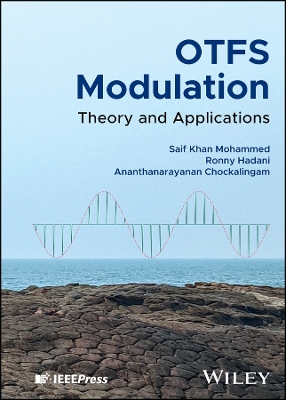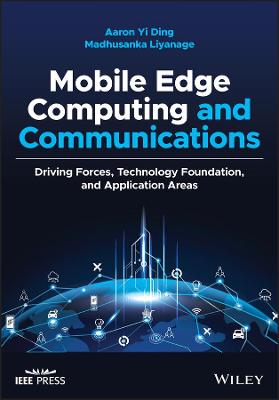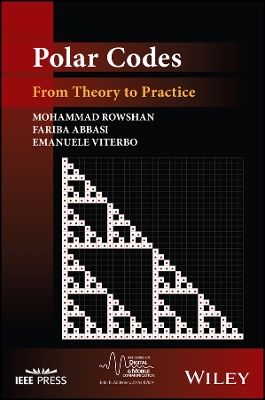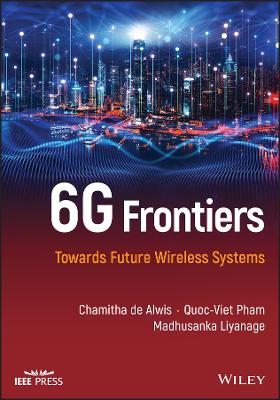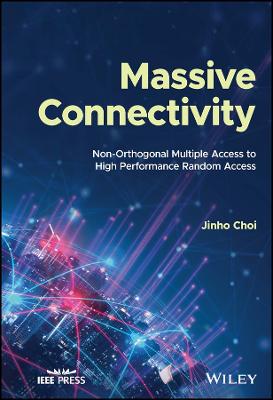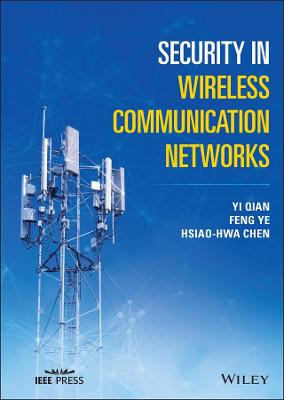Smart and Sustainable Approaches for Optimizing Performance of Wireless Networks
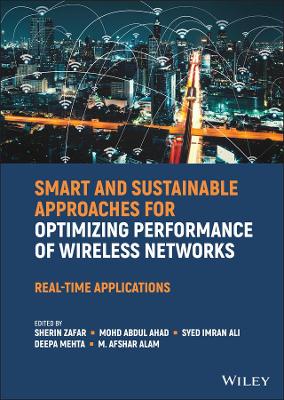 -15%
portes grátis
-15%
portes grátis
Smart and Sustainable Approaches for Optimizing Performance of Wireless Networks
Real-time Applications
Ahad, Mohd Abdul; Zafar, Sherin; Ali, Syed Imran; Alam, M. Afshar; Mehta, Deepa
John Wiley & Sons Inc
02/2022
320
Dura
Inglês
9781119682509
15 a 20 dias
700
Descrição não disponível.
1 Analysis and Clustering of Sensor Recorded Data to Determine Sensors Consuming the Least Energy
Prashant Abbi, Khushi Arora, Praveen Kumar Gupta, K.B. Ashwini, V. Chayapathy, and M.J. Vidya
1.1 Importance of Low Energy Consumption Sensors
1.2 Methodology: Clustering Using K Means and Classification Using KNN
1.3 Objective Realization and Result of Analysis
1.4 Introduction
1.5 Working of WSNs and Sensor Nodes
1.6 Classification of WSNs
1.6.1 Benefits and Drawbacks of Centralized Techniques
1.6.2 Benefits and Drawbacks of Distributed Techniques
1.7 Security Issues
1.7.1 Layering of Level Based Security
1.8 Energy Consumption Issues
1.9 Commonly Used Standards and Protocols for WSNs
1.9.1 Slotted Protocols
1.9.1.1 Time Division Multiple Access
1.9.1.2 Zig Bee/801.15.4
1.9.1.3 Sensor Medium Access Control
1.10 Effects of Temperature and Humidity on the Energy of WSNs
1.10.1 Effects of Temperature on Signal Strength
1.10.2 Effects of Humidity on Signal Strength
1.10.3 Temperature Vs. Humidity
1.11 Proposed Methodology
1.11.1 Information Gathering and Analysis
1.11.2 System Design and Implementation
1.11.3 Testing and Evaluation
1.12 Conclusion
References
2 Impact of Artificial Intelligence in Designing of 5G
K. Maheswari, Mohankumar, and Banuroopa
2.1 5G - An Introduction
2.1.1 Industry Applications
2.1.2 Healthcare
2.1.3 Retail
2.1.4 Agriculture
2.1.5 Manufacturing
2.1.6 Logistics
2.1.7 Sustainability of 5G Networks
2.1.8 Implementation of 5G
2.1.9 Architecture of 5G Technology
2.2 5G and AI
2.2.1 Gaming and Virtual Reality
2.3 AI and 5G
2.3.1 Continuous Learning AI Model
2.4 Challenges and Roadmap
2.4.1 Technical Issues
2.4.2 Technology Roadmap
2.4.3 Deployment Roadmap
2.5 Mathematical Models
2.5.1 The Insights of Mathematical Modeling in 5G Networks
2.6 Conclusion
References
3 Sustainable Paradigm for Computing the Security of Wireless Internet of Things: Blockchain Technology
Sana Zeba, Mohammed Amjad, and Danish Raza Rizvi
3.1 Introduction
3.2 Research Background
3.2.1 The Internet of Things
3.2.1.1 Security Requirements in Wireless IoT
3.2.1.2 Layered Architecture of Wireless IoT
3.2.2 Blockchain Technology
3.2.2.1 Types of Blockchain
3.2.2.2 Integration of Blockchain with Wireless Internet of Things
3.3 Related Work
3.3.1 Security Issues in Wireless IoT System
3.3.2 Solutions of Wireless IoT Security Problem
3.4 Research Methodology
3.5 Comparison of Various Existing Solutions
3.6 Discussion of Research Questions
3.7 Future Scope of Blockchain in IoT
3.8 Conclusion
References
4 Cognitive IoT Based Health Monitoring Scheme Using Non-Orthogonal MultipleAccess
Ashiqur Rahman Rahul, Saifur Rahman Sabuj, Majumder Fazle Haider, andShakil Ahmed
4.1 Introduction
4.2 Related Work
4.3 System Model and Implementation
4.3.1 Network Description
4.3.2 Sensing and Transmission Analysis
4.3.3 Pathloss Model
4.3.4 Mathematical Model Evaluation
4.3.4.1 Effectual Throughput
4.3.4.2 Interference Throughput
4.3.4.3 Energy Efficiency
4.3.4.4 Optimum Power
4.3.4.4.1 Optimum Power Derivation for HRC
4.2.3.4.2 Optimum Power Derivation for MRC
4.4 Simulation Results
4.5 Conclusion
4.A Appendices
4.A.1 Proof of Optimum Power Transmission for HRC Device at EffectualState (z = 0)
4.A.2 Proof of Optimum Power Transmission for HRC Device inInterference State (z = 1)
4.A.3 Proof of Optimum Power Transmission for MRC Device at EffectualState (z = 0)
4.A.4 Proof of Optimum Power Transmission for MRC Device inInterference State (z = 1)
References
5 Overview of Resource Management for Wireless Adhoc Network
Mehajabeen Fatima and Afreen Khueaheed
5.1 Introduction
5.1.1 Wired and Wireless Network Design Approach
5.1.2 History
5.1.3 Spectrum of Wireless Adhoc Network
5.1.4 Enabling and Networking Technologies
5.1.5 Taxonomy of Wireless Adhoc Network (WANET)
5.2 Mobile Adhoc Network (MANET)
5.2.1 Introduction to MANET
5.2.2 Common Characteristics of MANET
5.2.3 Advantages and Disadvantages
5.2.4 Applications of MANET
5.2.5 Major Issues of MANET
5.3 Vehicular Adhoc Network (VANET)
5.3.1 Introduction of VANET
5.3.2 Common Features of VANET
5.3.3 Pros, Cons, Applications
5.4 Wireless Mesh Network (WMN)
5.4.1 Preface of WMN
5.4.2 Common Traits of WMN
5.4.3 WMN Has Many Open Issues and Research Challenges
5.4.4 Performance Metrics
5.4.5 Advantages and Disadvantages
5.4.6 Prominent Areas and Challenges of WMN
5.5 Wireless Sensor Network (WSN)
5.5.1 Overview of WSN
5.5.2 Common Properties of WSN
5.5.3 Benefits, Harms, and Usage of WSN
5.6 Intelligent Management in WANET
5.6.1 Major Issues of WANET
5.6.2 Challenges of MAC Protocols
5.6.3 Routing Protocols
5.6.3.1 Challenges of Routing Protocols
5.6.3.1.1 Scalability
5.6.3.1.2 Quality of Service
5.6.3.1.3 Security
5.6.4 Energy and Battery Management
5.7 Future Research Directions
5.8 Conclusion
References
6 Survey: Brain Tumor Detection Using MRI Image with Deep Learning Techniques
Chalapathiraju Kanumuri and C.H. Renu Madhavi
6.1 Introduction
6.2 Background
6.2.1 Types of Medical Imaging
6.2.2 M. R. Imaging as a Modality
6.2.3 Types of Brain Tumor M. R. Imaging Modalities
6.2.4 Suitable Technologies Before Machine Learning
6.2.5 MRI Brain Image Segmentation
6.3 Related Work
6.4 Gaps and Observations
6.5 Suggestions
6.6 Conclusion
References
7 Challenges, Standards, and Solutions for Secure and Intelligent 5G Internet of Things (IoT) Scenarios
Ayasha Malik and Bharat Bhushan
7.1 Introduction
7.2 Safety in Wireless Networks: Since 1G to 4G
7.2.1 Safety in Non-IP Networks
7.2.2 Safety in 3G
7.2.3 Security in 4G
7.2.4 Security in 5G
7.2.4.1 Flashy System Traffic and Radio Visual Security Keys
7.2.4.2 Authorized Network Security and Compliance with Subscriber Level Safety Policies
7.2.5 Security in 5G and Beyond
7.3 IoT Background and Requirements
7.3.1 IoT and Its Characteristics
7.3.2 Characteristics of IoT Infrastructure
7.3.3 Characteristics of IoT Applications
7.3.4 Expected Benefits of IoT Adoption for Organization
7.3.4.1 Benefits Correlated to Big Data Created by IoT
7.3.4.2 Benefits Interrelated to the Openness of IoT
7.3.4.3 BenefitsRelated to the Linked Aspect6 of IoT
7.4 Non 5G Standards Supporting IoT
7.4.1 Bluetooth Low Energy
7.4.2 IEEE 802.15.4
7.4.3 LoRa
7.4.4 Sigfox
7.4.5. WiFi HaLow
7.5 5 G Advanced Security Model
7.5.1 Confidentiality
7.5.2 Integrity
7.5.3 Accessibility
7.5.4 Integrated Safety Rule
7.5.5 Visibility
7.6 Safety Challenges and Resolution of Three-Tiers Structure of 5G Networks
7.6.1 Heterogeneous Access Networks
7.6.1.1 Safety Challengers
7.6.1.2 Safety Resolutions
7.6.2 Backhaul Networks
7.6.2.1 Safety Challenges
7.6.2.2 Safety Resolutions
7.6.3 Core Network
7.6.3.1 Safety Challenges
7.6.3.2 Safety Resolutions
7.7 Conclusion and Future Research Directions
References
8 Blockchain Assisted Secure Data Sharing in Intelligent Transportation Systems
Gujkan Madaan, Avinash Kumar, and Bharat Bhushan
8.1 Introduction
8.2 Intelligent Transport System
8.2.1 ITS Overview
8.2.2 Issues in ITS
8.2.3 ITS Role in IoT
8.3 Blockchain Technology
8.3.1 Overview
8.3.2 Types of Blockchain
8.3.2.1 Public Blockchain
8.3.2.3 Private Blockchain
8.2.3.2 Federated Blockchain
8.3.3 Consensus Mechanism
8.3.3.1 Proof of Work
8.3.3.2 Proof of Stake
8.3.3.3 Delegated Proof of Stake
8.3.3.4 Practical Byzantine Fault Tolerance
8.3.3.5 Casper
8.3.3.6 Ripple
8.3.3.7 Proof of Activity
8.3.4 Cryptography
8.3.5 Data Management and Its Structure
8.4 Blockchain Assisted Intelligent Transportation System
8.4.1 Security and Privacy
8.4.2 Blockchain and Its Application foe Improving Security and Privacy
8.4.3 ITS Based on Blockchain
8.4.4 Recent Advancement
8.5 Future Research Perspectives
8.5.1 Electric Vehicle Recharging
8.5.2 Smart City Enabling and Smart Vehicle Security
8.5.3 Deferentially-Privacy Preserving Solutions
8.5.4 Distribution of Economic Profits and Incentives
8.6 Conclusion
References
9 Utilization of Agro Waste for Energy Engineering Applications: Toward the Manufacturing of Batteries and Super Capacitors
S.N. Kumar, S. Akhil, R.P. Nishita, O. Lijo Joseph, Aju Matthew George, and I Christina Jane
9.1 Introduction
9.2 Super Capacitors and Electrode Materials
9.2.1 Energy Density
9.3 Related Works in the Utilization of Agro Waste for Energy EngineeringApplications
9.4 Inferences from Work Related with Utilization of Coconut. Rice Husk, andPineapple Waste for Fabrication of Super Capacitor
9.5 Factors Contributing in the Fabrication of Super Capacitor from Agro Waste
9.6 Conclusion
Acknowledgment
References
10 Computational Intelligence Techiques for Optimization in Networks
Ashu Gautam and Rashima Mahajan
10.1 Introduction Focussing on Pedagogy of Impending Approach
10.1.1 Security Challenge in Networks
10.1.2 Attacks Vulnerability in Complex Networks
10.2 Relevant Analysis
10.3 Broad Area of Research
10.3.1 Routing Protocols
10.3.2 Hybrid Protocols
10.4 Problem Identification
10.5 Objectives of the Study
10.6 Methodology to be Adopted
10.7 Proposed/Expected Outcome of the Research
References
11 R&D Export and ICT Regimes in India
Zeba, M. Afshar Alam, Harleen Kaur*, Ihtiram Raza Khan, Bhavya Alankar
Corresponding Author: Harleen Kaur
11.1 Introduction
11.2 Artificial Intelligence: the Uptake of Infrastructure Development
11.3 Future Analysis and Conclusion
References
12 Metaheuristics to Aid Energy-Efficient Path Selection in Route Aggregated Mobile Ad Hoc Networks
Deepa Mehta, Sherin Zafar, Siddhartha Sankar Biswas, Nida Iftekhar, and Samia Khan
12.1 Introduction
12.2 Framework
12.2.1 Route Aggregation
12.3 Clustering
12.4 Ant Colony Optimization
12.4.1 Setting Parameters and Initializing
12.4.2 Generating Solutions
12.4.3 Pheromone Update
12.5 Methodology
12.5.1 Energy Efficient ACO Algorithm
12.5.2 ACO Aided Cluster and Head Selection
12.5.3 ACO Aided Route Aggregation
12.5.4 ACO Aided Energy: Efficient Path Selection
12.6 Results
12.7 Discussion
12.8 Conclusion
References
13 Knowledge Analytics in IOMT-MANET Through QoS Optimization for Sustainability
Neha Sharma, Nida Iftekhar, and Samia Khan
13.1 Introduction
13.2 Related Work
13.3 Proposed Neoteric Nature Inspired IWD Algorithm for ZRP
13.4 Simulation Results
13.5 Conclusion and Future Work
References
14 Appraise Assortment of IOT Security Optimization
Ayesha Hena Afzal and M. Afshar Alam
14.1 Introduction
14.2 Literature Review
14.3 Analysis of Traditional Security Mechanisms in IOT
14.4 Conclusion and Future Scope
References
15 Trust Based Hybrid Routing Approach for Securing MANET
Neha Sharma and Satrupa Biswas
15.1 Introduction
15.2 Literature Review
15.3 Gaps and Objectives from the Literature Review
15.4 Methodology to be Adopted
15.5 Comparison Analysis
15.6 Conclusion and Future Scope
References
16 Study of Security Issues on Open Channel
Md Mudassir Chaudhary, Siddhartha Sankar Biswas, Md Tabrez Nafis, and Safdar Tenweer
16.1 Introduction
16.2 Wireless Attacks
16.2.1 Reconnaissance Attack
16.2.2 Access Attacks
16.2.3 Man-in-the-Middle Attack
16.2.4 Denial of Services (DOS)
16.3 Securing Wireless Transmissions
16.3.1 Protecting the Confidentiality
16.3.2 Protecting the Modification
16.3.3 Preventing Interruption of Denial-of-Service Attack
16.4 Proposed Model for Securing the Client Over the Channel
16.5 Conclusion
References
Prashant Abbi, Khushi Arora, Praveen Kumar Gupta, K.B. Ashwini, V. Chayapathy, and M.J. Vidya
1.1 Importance of Low Energy Consumption Sensors
1.2 Methodology: Clustering Using K Means and Classification Using KNN
1.3 Objective Realization and Result of Analysis
1.4 Introduction
1.5 Working of WSNs and Sensor Nodes
1.6 Classification of WSNs
1.6.1 Benefits and Drawbacks of Centralized Techniques
1.6.2 Benefits and Drawbacks of Distributed Techniques
1.7 Security Issues
1.7.1 Layering of Level Based Security
1.8 Energy Consumption Issues
1.9 Commonly Used Standards and Protocols for WSNs
1.9.1 Slotted Protocols
1.9.1.1 Time Division Multiple Access
1.9.1.2 Zig Bee/801.15.4
1.9.1.3 Sensor Medium Access Control
1.10 Effects of Temperature and Humidity on the Energy of WSNs
1.10.1 Effects of Temperature on Signal Strength
1.10.2 Effects of Humidity on Signal Strength
1.10.3 Temperature Vs. Humidity
1.11 Proposed Methodology
1.11.1 Information Gathering and Analysis
1.11.2 System Design and Implementation
1.11.3 Testing and Evaluation
1.12 Conclusion
References
2 Impact of Artificial Intelligence in Designing of 5G
K. Maheswari, Mohankumar, and Banuroopa
2.1 5G - An Introduction
2.1.1 Industry Applications
2.1.2 Healthcare
2.1.3 Retail
2.1.4 Agriculture
2.1.5 Manufacturing
2.1.6 Logistics
2.1.7 Sustainability of 5G Networks
2.1.8 Implementation of 5G
2.1.9 Architecture of 5G Technology
2.2 5G and AI
2.2.1 Gaming and Virtual Reality
2.3 AI and 5G
2.3.1 Continuous Learning AI Model
2.4 Challenges and Roadmap
2.4.1 Technical Issues
2.4.2 Technology Roadmap
2.4.3 Deployment Roadmap
2.5 Mathematical Models
2.5.1 The Insights of Mathematical Modeling in 5G Networks
2.6 Conclusion
References
3 Sustainable Paradigm for Computing the Security of Wireless Internet of Things: Blockchain Technology
Sana Zeba, Mohammed Amjad, and Danish Raza Rizvi
3.1 Introduction
3.2 Research Background
3.2.1 The Internet of Things
3.2.1.1 Security Requirements in Wireless IoT
3.2.1.2 Layered Architecture of Wireless IoT
3.2.2 Blockchain Technology
3.2.2.1 Types of Blockchain
3.2.2.2 Integration of Blockchain with Wireless Internet of Things
3.3 Related Work
3.3.1 Security Issues in Wireless IoT System
3.3.2 Solutions of Wireless IoT Security Problem
3.4 Research Methodology
3.5 Comparison of Various Existing Solutions
3.6 Discussion of Research Questions
3.7 Future Scope of Blockchain in IoT
3.8 Conclusion
References
4 Cognitive IoT Based Health Monitoring Scheme Using Non-Orthogonal MultipleAccess
Ashiqur Rahman Rahul, Saifur Rahman Sabuj, Majumder Fazle Haider, andShakil Ahmed
4.1 Introduction
4.2 Related Work
4.3 System Model and Implementation
4.3.1 Network Description
4.3.2 Sensing and Transmission Analysis
4.3.3 Pathloss Model
4.3.4 Mathematical Model Evaluation
4.3.4.1 Effectual Throughput
4.3.4.2 Interference Throughput
4.3.4.3 Energy Efficiency
4.3.4.4 Optimum Power
4.3.4.4.1 Optimum Power Derivation for HRC
4.2.3.4.2 Optimum Power Derivation for MRC
4.4 Simulation Results
4.5 Conclusion
4.A Appendices
4.A.1 Proof of Optimum Power Transmission for HRC Device at EffectualState (z = 0)
4.A.2 Proof of Optimum Power Transmission for HRC Device inInterference State (z = 1)
4.A.3 Proof of Optimum Power Transmission for MRC Device at EffectualState (z = 0)
4.A.4 Proof of Optimum Power Transmission for MRC Device inInterference State (z = 1)
References
5 Overview of Resource Management for Wireless Adhoc Network
Mehajabeen Fatima and Afreen Khueaheed
5.1 Introduction
5.1.1 Wired and Wireless Network Design Approach
5.1.2 History
5.1.3 Spectrum of Wireless Adhoc Network
5.1.4 Enabling and Networking Technologies
5.1.5 Taxonomy of Wireless Adhoc Network (WANET)
5.2 Mobile Adhoc Network (MANET)
5.2.1 Introduction to MANET
5.2.2 Common Characteristics of MANET
5.2.3 Advantages and Disadvantages
5.2.4 Applications of MANET
5.2.5 Major Issues of MANET
5.3 Vehicular Adhoc Network (VANET)
5.3.1 Introduction of VANET
5.3.2 Common Features of VANET
5.3.3 Pros, Cons, Applications
5.4 Wireless Mesh Network (WMN)
5.4.1 Preface of WMN
5.4.2 Common Traits of WMN
5.4.3 WMN Has Many Open Issues and Research Challenges
5.4.4 Performance Metrics
5.4.5 Advantages and Disadvantages
5.4.6 Prominent Areas and Challenges of WMN
5.5 Wireless Sensor Network (WSN)
5.5.1 Overview of WSN
5.5.2 Common Properties of WSN
5.5.3 Benefits, Harms, and Usage of WSN
5.6 Intelligent Management in WANET
5.6.1 Major Issues of WANET
5.6.2 Challenges of MAC Protocols
5.6.3 Routing Protocols
5.6.3.1 Challenges of Routing Protocols
5.6.3.1.1 Scalability
5.6.3.1.2 Quality of Service
5.6.3.1.3 Security
5.6.4 Energy and Battery Management
5.7 Future Research Directions
5.8 Conclusion
References
6 Survey: Brain Tumor Detection Using MRI Image with Deep Learning Techniques
Chalapathiraju Kanumuri and C.H. Renu Madhavi
6.1 Introduction
6.2 Background
6.2.1 Types of Medical Imaging
6.2.2 M. R. Imaging as a Modality
6.2.3 Types of Brain Tumor M. R. Imaging Modalities
6.2.4 Suitable Technologies Before Machine Learning
6.2.5 MRI Brain Image Segmentation
6.3 Related Work
6.4 Gaps and Observations
6.5 Suggestions
6.6 Conclusion
References
7 Challenges, Standards, and Solutions for Secure and Intelligent 5G Internet of Things (IoT) Scenarios
Ayasha Malik and Bharat Bhushan
7.1 Introduction
7.2 Safety in Wireless Networks: Since 1G to 4G
7.2.1 Safety in Non-IP Networks
7.2.2 Safety in 3G
7.2.3 Security in 4G
7.2.4 Security in 5G
7.2.4.1 Flashy System Traffic and Radio Visual Security Keys
7.2.4.2 Authorized Network Security and Compliance with Subscriber Level Safety Policies
7.2.5 Security in 5G and Beyond
7.3 IoT Background and Requirements
7.3.1 IoT and Its Characteristics
7.3.2 Characteristics of IoT Infrastructure
7.3.3 Characteristics of IoT Applications
7.3.4 Expected Benefits of IoT Adoption for Organization
7.3.4.1 Benefits Correlated to Big Data Created by IoT
7.3.4.2 Benefits Interrelated to the Openness of IoT
7.3.4.3 BenefitsRelated to the Linked Aspect6 of IoT
7.4 Non 5G Standards Supporting IoT
7.4.1 Bluetooth Low Energy
7.4.2 IEEE 802.15.4
7.4.3 LoRa
7.4.4 Sigfox
7.4.5. WiFi HaLow
7.5 5 G Advanced Security Model
7.5.1 Confidentiality
7.5.2 Integrity
7.5.3 Accessibility
7.5.4 Integrated Safety Rule
7.5.5 Visibility
7.6 Safety Challenges and Resolution of Three-Tiers Structure of 5G Networks
7.6.1 Heterogeneous Access Networks
7.6.1.1 Safety Challengers
7.6.1.2 Safety Resolutions
7.6.2 Backhaul Networks
7.6.2.1 Safety Challenges
7.6.2.2 Safety Resolutions
7.6.3 Core Network
7.6.3.1 Safety Challenges
7.6.3.2 Safety Resolutions
7.7 Conclusion and Future Research Directions
References
8 Blockchain Assisted Secure Data Sharing in Intelligent Transportation Systems
Gujkan Madaan, Avinash Kumar, and Bharat Bhushan
8.1 Introduction
8.2 Intelligent Transport System
8.2.1 ITS Overview
8.2.2 Issues in ITS
8.2.3 ITS Role in IoT
8.3 Blockchain Technology
8.3.1 Overview
8.3.2 Types of Blockchain
8.3.2.1 Public Blockchain
8.3.2.3 Private Blockchain
8.2.3.2 Federated Blockchain
8.3.3 Consensus Mechanism
8.3.3.1 Proof of Work
8.3.3.2 Proof of Stake
8.3.3.3 Delegated Proof of Stake
8.3.3.4 Practical Byzantine Fault Tolerance
8.3.3.5 Casper
8.3.3.6 Ripple
8.3.3.7 Proof of Activity
8.3.4 Cryptography
8.3.5 Data Management and Its Structure
8.4 Blockchain Assisted Intelligent Transportation System
8.4.1 Security and Privacy
8.4.2 Blockchain and Its Application foe Improving Security and Privacy
8.4.3 ITS Based on Blockchain
8.4.4 Recent Advancement
8.5 Future Research Perspectives
8.5.1 Electric Vehicle Recharging
8.5.2 Smart City Enabling and Smart Vehicle Security
8.5.3 Deferentially-Privacy Preserving Solutions
8.5.4 Distribution of Economic Profits and Incentives
8.6 Conclusion
References
9 Utilization of Agro Waste for Energy Engineering Applications: Toward the Manufacturing of Batteries and Super Capacitors
S.N. Kumar, S. Akhil, R.P. Nishita, O. Lijo Joseph, Aju Matthew George, and I Christina Jane
9.1 Introduction
9.2 Super Capacitors and Electrode Materials
9.2.1 Energy Density
9.3 Related Works in the Utilization of Agro Waste for Energy EngineeringApplications
9.4 Inferences from Work Related with Utilization of Coconut. Rice Husk, andPineapple Waste for Fabrication of Super Capacitor
9.5 Factors Contributing in the Fabrication of Super Capacitor from Agro Waste
9.6 Conclusion
Acknowledgment
References
10 Computational Intelligence Techiques for Optimization in Networks
Ashu Gautam and Rashima Mahajan
10.1 Introduction Focussing on Pedagogy of Impending Approach
10.1.1 Security Challenge in Networks
10.1.2 Attacks Vulnerability in Complex Networks
10.2 Relevant Analysis
10.3 Broad Area of Research
10.3.1 Routing Protocols
10.3.2 Hybrid Protocols
10.4 Problem Identification
10.5 Objectives of the Study
10.6 Methodology to be Adopted
10.7 Proposed/Expected Outcome of the Research
References
11 R&D Export and ICT Regimes in India
Zeba, M. Afshar Alam, Harleen Kaur*, Ihtiram Raza Khan, Bhavya Alankar
Corresponding Author: Harleen Kaur
11.1 Introduction
11.2 Artificial Intelligence: the Uptake of Infrastructure Development
11.3 Future Analysis and Conclusion
References
12 Metaheuristics to Aid Energy-Efficient Path Selection in Route Aggregated Mobile Ad Hoc Networks
Deepa Mehta, Sherin Zafar, Siddhartha Sankar Biswas, Nida Iftekhar, and Samia Khan
12.1 Introduction
12.2 Framework
12.2.1 Route Aggregation
12.3 Clustering
12.4 Ant Colony Optimization
12.4.1 Setting Parameters and Initializing
12.4.2 Generating Solutions
12.4.3 Pheromone Update
12.5 Methodology
12.5.1 Energy Efficient ACO Algorithm
12.5.2 ACO Aided Cluster and Head Selection
12.5.3 ACO Aided Route Aggregation
12.5.4 ACO Aided Energy: Efficient Path Selection
12.6 Results
12.7 Discussion
12.8 Conclusion
References
13 Knowledge Analytics in IOMT-MANET Through QoS Optimization for Sustainability
Neha Sharma, Nida Iftekhar, and Samia Khan
13.1 Introduction
13.2 Related Work
13.3 Proposed Neoteric Nature Inspired IWD Algorithm for ZRP
13.4 Simulation Results
13.5 Conclusion and Future Work
References
14 Appraise Assortment of IOT Security Optimization
Ayesha Hena Afzal and M. Afshar Alam
14.1 Introduction
14.2 Literature Review
14.3 Analysis of Traditional Security Mechanisms in IOT
14.4 Conclusion and Future Scope
References
15 Trust Based Hybrid Routing Approach for Securing MANET
Neha Sharma and Satrupa Biswas
15.1 Introduction
15.2 Literature Review
15.3 Gaps and Objectives from the Literature Review
15.4 Methodology to be Adopted
15.5 Comparison Analysis
15.6 Conclusion and Future Scope
References
16 Study of Security Issues on Open Channel
Md Mudassir Chaudhary, Siddhartha Sankar Biswas, Md Tabrez Nafis, and Safdar Tenweer
16.1 Introduction
16.2 Wireless Attacks
16.2.1 Reconnaissance Attack
16.2.2 Access Attacks
16.2.3 Man-in-the-Middle Attack
16.2.4 Denial of Services (DOS)
16.3 Securing Wireless Transmissions
16.3.1 Protecting the Confidentiality
16.3.2 Protecting the Modification
16.3.3 Preventing Interruption of Denial-of-Service Attack
16.4 Proposed Model for Securing the Client Over the Channel
16.5 Conclusion
References
Este título pertence ao(s) assunto(s) indicados(s). Para ver outros títulos clique no assunto desejado.
smart 5G networks; sustainable 5G networks; smart wireless sensing; sustainable wireless sensing; 5G wireless performance optimization; 5G green computing; 5G green automation; wireless green automation; wireless green computing; green IoT
1 Analysis and Clustering of Sensor Recorded Data to Determine Sensors Consuming the Least Energy
Prashant Abbi, Khushi Arora, Praveen Kumar Gupta, K.B. Ashwini, V. Chayapathy, and M.J. Vidya
1.1 Importance of Low Energy Consumption Sensors
1.2 Methodology: Clustering Using K Means and Classification Using KNN
1.3 Objective Realization and Result of Analysis
1.4 Introduction
1.5 Working of WSNs and Sensor Nodes
1.6 Classification of WSNs
1.6.1 Benefits and Drawbacks of Centralized Techniques
1.6.2 Benefits and Drawbacks of Distributed Techniques
1.7 Security Issues
1.7.1 Layering of Level Based Security
1.8 Energy Consumption Issues
1.9 Commonly Used Standards and Protocols for WSNs
1.9.1 Slotted Protocols
1.9.1.1 Time Division Multiple Access
1.9.1.2 Zig Bee/801.15.4
1.9.1.3 Sensor Medium Access Control
1.10 Effects of Temperature and Humidity on the Energy of WSNs
1.10.1 Effects of Temperature on Signal Strength
1.10.2 Effects of Humidity on Signal Strength
1.10.3 Temperature Vs. Humidity
1.11 Proposed Methodology
1.11.1 Information Gathering and Analysis
1.11.2 System Design and Implementation
1.11.3 Testing and Evaluation
1.12 Conclusion
References
2 Impact of Artificial Intelligence in Designing of 5G
K. Maheswari, Mohankumar, and Banuroopa
2.1 5G - An Introduction
2.1.1 Industry Applications
2.1.2 Healthcare
2.1.3 Retail
2.1.4 Agriculture
2.1.5 Manufacturing
2.1.6 Logistics
2.1.7 Sustainability of 5G Networks
2.1.8 Implementation of 5G
2.1.9 Architecture of 5G Technology
2.2 5G and AI
2.2.1 Gaming and Virtual Reality
2.3 AI and 5G
2.3.1 Continuous Learning AI Model
2.4 Challenges and Roadmap
2.4.1 Technical Issues
2.4.2 Technology Roadmap
2.4.3 Deployment Roadmap
2.5 Mathematical Models
2.5.1 The Insights of Mathematical Modeling in 5G Networks
2.6 Conclusion
References
3 Sustainable Paradigm for Computing the Security of Wireless Internet of Things: Blockchain Technology
Sana Zeba, Mohammed Amjad, and Danish Raza Rizvi
3.1 Introduction
3.2 Research Background
3.2.1 The Internet of Things
3.2.1.1 Security Requirements in Wireless IoT
3.2.1.2 Layered Architecture of Wireless IoT
3.2.2 Blockchain Technology
3.2.2.1 Types of Blockchain
3.2.2.2 Integration of Blockchain with Wireless Internet of Things
3.3 Related Work
3.3.1 Security Issues in Wireless IoT System
3.3.2 Solutions of Wireless IoT Security Problem
3.4 Research Methodology
3.5 Comparison of Various Existing Solutions
3.6 Discussion of Research Questions
3.7 Future Scope of Blockchain in IoT
3.8 Conclusion
References
4 Cognitive IoT Based Health Monitoring Scheme Using Non-Orthogonal MultipleAccess
Ashiqur Rahman Rahul, Saifur Rahman Sabuj, Majumder Fazle Haider, andShakil Ahmed
4.1 Introduction
4.2 Related Work
4.3 System Model and Implementation
4.3.1 Network Description
4.3.2 Sensing and Transmission Analysis
4.3.3 Pathloss Model
4.3.4 Mathematical Model Evaluation
4.3.4.1 Effectual Throughput
4.3.4.2 Interference Throughput
4.3.4.3 Energy Efficiency
4.3.4.4 Optimum Power
4.3.4.4.1 Optimum Power Derivation for HRC
4.2.3.4.2 Optimum Power Derivation for MRC
4.4 Simulation Results
4.5 Conclusion
4.A Appendices
4.A.1 Proof of Optimum Power Transmission for HRC Device at EffectualState (z = 0)
4.A.2 Proof of Optimum Power Transmission for HRC Device inInterference State (z = 1)
4.A.3 Proof of Optimum Power Transmission for MRC Device at EffectualState (z = 0)
4.A.4 Proof of Optimum Power Transmission for MRC Device inInterference State (z = 1)
References
5 Overview of Resource Management for Wireless Adhoc Network
Mehajabeen Fatima and Afreen Khueaheed
5.1 Introduction
5.1.1 Wired and Wireless Network Design Approach
5.1.2 History
5.1.3 Spectrum of Wireless Adhoc Network
5.1.4 Enabling and Networking Technologies
5.1.5 Taxonomy of Wireless Adhoc Network (WANET)
5.2 Mobile Adhoc Network (MANET)
5.2.1 Introduction to MANET
5.2.2 Common Characteristics of MANET
5.2.3 Advantages and Disadvantages
5.2.4 Applications of MANET
5.2.5 Major Issues of MANET
5.3 Vehicular Adhoc Network (VANET)
5.3.1 Introduction of VANET
5.3.2 Common Features of VANET
5.3.3 Pros, Cons, Applications
5.4 Wireless Mesh Network (WMN)
5.4.1 Preface of WMN
5.4.2 Common Traits of WMN
5.4.3 WMN Has Many Open Issues and Research Challenges
5.4.4 Performance Metrics
5.4.5 Advantages and Disadvantages
5.4.6 Prominent Areas and Challenges of WMN
5.5 Wireless Sensor Network (WSN)
5.5.1 Overview of WSN
5.5.2 Common Properties of WSN
5.5.3 Benefits, Harms, and Usage of WSN
5.6 Intelligent Management in WANET
5.6.1 Major Issues of WANET
5.6.2 Challenges of MAC Protocols
5.6.3 Routing Protocols
5.6.3.1 Challenges of Routing Protocols
5.6.3.1.1 Scalability
5.6.3.1.2 Quality of Service
5.6.3.1.3 Security
5.6.4 Energy and Battery Management
5.7 Future Research Directions
5.8 Conclusion
References
6 Survey: Brain Tumor Detection Using MRI Image with Deep Learning Techniques
Chalapathiraju Kanumuri and C.H. Renu Madhavi
6.1 Introduction
6.2 Background
6.2.1 Types of Medical Imaging
6.2.2 M. R. Imaging as a Modality
6.2.3 Types of Brain Tumor M. R. Imaging Modalities
6.2.4 Suitable Technologies Before Machine Learning
6.2.5 MRI Brain Image Segmentation
6.3 Related Work
6.4 Gaps and Observations
6.5 Suggestions
6.6 Conclusion
References
7 Challenges, Standards, and Solutions for Secure and Intelligent 5G Internet of Things (IoT) Scenarios
Ayasha Malik and Bharat Bhushan
7.1 Introduction
7.2 Safety in Wireless Networks: Since 1G to 4G
7.2.1 Safety in Non-IP Networks
7.2.2 Safety in 3G
7.2.3 Security in 4G
7.2.4 Security in 5G
7.2.4.1 Flashy System Traffic and Radio Visual Security Keys
7.2.4.2 Authorized Network Security and Compliance with Subscriber Level Safety Policies
7.2.5 Security in 5G and Beyond
7.3 IoT Background and Requirements
7.3.1 IoT and Its Characteristics
7.3.2 Characteristics of IoT Infrastructure
7.3.3 Characteristics of IoT Applications
7.3.4 Expected Benefits of IoT Adoption for Organization
7.3.4.1 Benefits Correlated to Big Data Created by IoT
7.3.4.2 Benefits Interrelated to the Openness of IoT
7.3.4.3 BenefitsRelated to the Linked Aspect6 of IoT
7.4 Non 5G Standards Supporting IoT
7.4.1 Bluetooth Low Energy
7.4.2 IEEE 802.15.4
7.4.3 LoRa
7.4.4 Sigfox
7.4.5. WiFi HaLow
7.5 5 G Advanced Security Model
7.5.1 Confidentiality
7.5.2 Integrity
7.5.3 Accessibility
7.5.4 Integrated Safety Rule
7.5.5 Visibility
7.6 Safety Challenges and Resolution of Three-Tiers Structure of 5G Networks
7.6.1 Heterogeneous Access Networks
7.6.1.1 Safety Challengers
7.6.1.2 Safety Resolutions
7.6.2 Backhaul Networks
7.6.2.1 Safety Challenges
7.6.2.2 Safety Resolutions
7.6.3 Core Network
7.6.3.1 Safety Challenges
7.6.3.2 Safety Resolutions
7.7 Conclusion and Future Research Directions
References
8 Blockchain Assisted Secure Data Sharing in Intelligent Transportation Systems
Gujkan Madaan, Avinash Kumar, and Bharat Bhushan
8.1 Introduction
8.2 Intelligent Transport System
8.2.1 ITS Overview
8.2.2 Issues in ITS
8.2.3 ITS Role in IoT
8.3 Blockchain Technology
8.3.1 Overview
8.3.2 Types of Blockchain
8.3.2.1 Public Blockchain
8.3.2.3 Private Blockchain
8.2.3.2 Federated Blockchain
8.3.3 Consensus Mechanism
8.3.3.1 Proof of Work
8.3.3.2 Proof of Stake
8.3.3.3 Delegated Proof of Stake
8.3.3.4 Practical Byzantine Fault Tolerance
8.3.3.5 Casper
8.3.3.6 Ripple
8.3.3.7 Proof of Activity
8.3.4 Cryptography
8.3.5 Data Management and Its Structure
8.4 Blockchain Assisted Intelligent Transportation System
8.4.1 Security and Privacy
8.4.2 Blockchain and Its Application foe Improving Security and Privacy
8.4.3 ITS Based on Blockchain
8.4.4 Recent Advancement
8.5 Future Research Perspectives
8.5.1 Electric Vehicle Recharging
8.5.2 Smart City Enabling and Smart Vehicle Security
8.5.3 Deferentially-Privacy Preserving Solutions
8.5.4 Distribution of Economic Profits and Incentives
8.6 Conclusion
References
9 Utilization of Agro Waste for Energy Engineering Applications: Toward the Manufacturing of Batteries and Super Capacitors
S.N. Kumar, S. Akhil, R.P. Nishita, O. Lijo Joseph, Aju Matthew George, and I Christina Jane
9.1 Introduction
9.2 Super Capacitors and Electrode Materials
9.2.1 Energy Density
9.3 Related Works in the Utilization of Agro Waste for Energy EngineeringApplications
9.4 Inferences from Work Related with Utilization of Coconut. Rice Husk, andPineapple Waste for Fabrication of Super Capacitor
9.5 Factors Contributing in the Fabrication of Super Capacitor from Agro Waste
9.6 Conclusion
Acknowledgment
References
10 Computational Intelligence Techiques for Optimization in Networks
Ashu Gautam and Rashima Mahajan
10.1 Introduction Focussing on Pedagogy of Impending Approach
10.1.1 Security Challenge in Networks
10.1.2 Attacks Vulnerability in Complex Networks
10.2 Relevant Analysis
10.3 Broad Area of Research
10.3.1 Routing Protocols
10.3.2 Hybrid Protocols
10.4 Problem Identification
10.5 Objectives of the Study
10.6 Methodology to be Adopted
10.7 Proposed/Expected Outcome of the Research
References
11 R&D Export and ICT Regimes in India
Zeba, M. Afshar Alam, Harleen Kaur*, Ihtiram Raza Khan, Bhavya Alankar
Corresponding Author: Harleen Kaur
11.1 Introduction
11.2 Artificial Intelligence: the Uptake of Infrastructure Development
11.3 Future Analysis and Conclusion
References
12 Metaheuristics to Aid Energy-Efficient Path Selection in Route Aggregated Mobile Ad Hoc Networks
Deepa Mehta, Sherin Zafar, Siddhartha Sankar Biswas, Nida Iftekhar, and Samia Khan
12.1 Introduction
12.2 Framework
12.2.1 Route Aggregation
12.3 Clustering
12.4 Ant Colony Optimization
12.4.1 Setting Parameters and Initializing
12.4.2 Generating Solutions
12.4.3 Pheromone Update
12.5 Methodology
12.5.1 Energy Efficient ACO Algorithm
12.5.2 ACO Aided Cluster and Head Selection
12.5.3 ACO Aided Route Aggregation
12.5.4 ACO Aided Energy: Efficient Path Selection
12.6 Results
12.7 Discussion
12.8 Conclusion
References
13 Knowledge Analytics in IOMT-MANET Through QoS Optimization for Sustainability
Neha Sharma, Nida Iftekhar, and Samia Khan
13.1 Introduction
13.2 Related Work
13.3 Proposed Neoteric Nature Inspired IWD Algorithm for ZRP
13.4 Simulation Results
13.5 Conclusion and Future Work
References
14 Appraise Assortment of IOT Security Optimization
Ayesha Hena Afzal and M. Afshar Alam
14.1 Introduction
14.2 Literature Review
14.3 Analysis of Traditional Security Mechanisms in IOT
14.4 Conclusion and Future Scope
References
15 Trust Based Hybrid Routing Approach for Securing MANET
Neha Sharma and Satrupa Biswas
15.1 Introduction
15.2 Literature Review
15.3 Gaps and Objectives from the Literature Review
15.4 Methodology to be Adopted
15.5 Comparison Analysis
15.6 Conclusion and Future Scope
References
16 Study of Security Issues on Open Channel
Md Mudassir Chaudhary, Siddhartha Sankar Biswas, Md Tabrez Nafis, and Safdar Tenweer
16.1 Introduction
16.2 Wireless Attacks
16.2.1 Reconnaissance Attack
16.2.2 Access Attacks
16.2.3 Man-in-the-Middle Attack
16.2.4 Denial of Services (DOS)
16.3 Securing Wireless Transmissions
16.3.1 Protecting the Confidentiality
16.3.2 Protecting the Modification
16.3.3 Preventing Interruption of Denial-of-Service Attack
16.4 Proposed Model for Securing the Client Over the Channel
16.5 Conclusion
References
Prashant Abbi, Khushi Arora, Praveen Kumar Gupta, K.B. Ashwini, V. Chayapathy, and M.J. Vidya
1.1 Importance of Low Energy Consumption Sensors
1.2 Methodology: Clustering Using K Means and Classification Using KNN
1.3 Objective Realization and Result of Analysis
1.4 Introduction
1.5 Working of WSNs and Sensor Nodes
1.6 Classification of WSNs
1.6.1 Benefits and Drawbacks of Centralized Techniques
1.6.2 Benefits and Drawbacks of Distributed Techniques
1.7 Security Issues
1.7.1 Layering of Level Based Security
1.8 Energy Consumption Issues
1.9 Commonly Used Standards and Protocols for WSNs
1.9.1 Slotted Protocols
1.9.1.1 Time Division Multiple Access
1.9.1.2 Zig Bee/801.15.4
1.9.1.3 Sensor Medium Access Control
1.10 Effects of Temperature and Humidity on the Energy of WSNs
1.10.1 Effects of Temperature on Signal Strength
1.10.2 Effects of Humidity on Signal Strength
1.10.3 Temperature Vs. Humidity
1.11 Proposed Methodology
1.11.1 Information Gathering and Analysis
1.11.2 System Design and Implementation
1.11.3 Testing and Evaluation
1.12 Conclusion
References
2 Impact of Artificial Intelligence in Designing of 5G
K. Maheswari, Mohankumar, and Banuroopa
2.1 5G - An Introduction
2.1.1 Industry Applications
2.1.2 Healthcare
2.1.3 Retail
2.1.4 Agriculture
2.1.5 Manufacturing
2.1.6 Logistics
2.1.7 Sustainability of 5G Networks
2.1.8 Implementation of 5G
2.1.9 Architecture of 5G Technology
2.2 5G and AI
2.2.1 Gaming and Virtual Reality
2.3 AI and 5G
2.3.1 Continuous Learning AI Model
2.4 Challenges and Roadmap
2.4.1 Technical Issues
2.4.2 Technology Roadmap
2.4.3 Deployment Roadmap
2.5 Mathematical Models
2.5.1 The Insights of Mathematical Modeling in 5G Networks
2.6 Conclusion
References
3 Sustainable Paradigm for Computing the Security of Wireless Internet of Things: Blockchain Technology
Sana Zeba, Mohammed Amjad, and Danish Raza Rizvi
3.1 Introduction
3.2 Research Background
3.2.1 The Internet of Things
3.2.1.1 Security Requirements in Wireless IoT
3.2.1.2 Layered Architecture of Wireless IoT
3.2.2 Blockchain Technology
3.2.2.1 Types of Blockchain
3.2.2.2 Integration of Blockchain with Wireless Internet of Things
3.3 Related Work
3.3.1 Security Issues in Wireless IoT System
3.3.2 Solutions of Wireless IoT Security Problem
3.4 Research Methodology
3.5 Comparison of Various Existing Solutions
3.6 Discussion of Research Questions
3.7 Future Scope of Blockchain in IoT
3.8 Conclusion
References
4 Cognitive IoT Based Health Monitoring Scheme Using Non-Orthogonal MultipleAccess
Ashiqur Rahman Rahul, Saifur Rahman Sabuj, Majumder Fazle Haider, andShakil Ahmed
4.1 Introduction
4.2 Related Work
4.3 System Model and Implementation
4.3.1 Network Description
4.3.2 Sensing and Transmission Analysis
4.3.3 Pathloss Model
4.3.4 Mathematical Model Evaluation
4.3.4.1 Effectual Throughput
4.3.4.2 Interference Throughput
4.3.4.3 Energy Efficiency
4.3.4.4 Optimum Power
4.3.4.4.1 Optimum Power Derivation for HRC
4.2.3.4.2 Optimum Power Derivation for MRC
4.4 Simulation Results
4.5 Conclusion
4.A Appendices
4.A.1 Proof of Optimum Power Transmission for HRC Device at EffectualState (z = 0)
4.A.2 Proof of Optimum Power Transmission for HRC Device inInterference State (z = 1)
4.A.3 Proof of Optimum Power Transmission for MRC Device at EffectualState (z = 0)
4.A.4 Proof of Optimum Power Transmission for MRC Device inInterference State (z = 1)
References
5 Overview of Resource Management for Wireless Adhoc Network
Mehajabeen Fatima and Afreen Khueaheed
5.1 Introduction
5.1.1 Wired and Wireless Network Design Approach
5.1.2 History
5.1.3 Spectrum of Wireless Adhoc Network
5.1.4 Enabling and Networking Technologies
5.1.5 Taxonomy of Wireless Adhoc Network (WANET)
5.2 Mobile Adhoc Network (MANET)
5.2.1 Introduction to MANET
5.2.2 Common Characteristics of MANET
5.2.3 Advantages and Disadvantages
5.2.4 Applications of MANET
5.2.5 Major Issues of MANET
5.3 Vehicular Adhoc Network (VANET)
5.3.1 Introduction of VANET
5.3.2 Common Features of VANET
5.3.3 Pros, Cons, Applications
5.4 Wireless Mesh Network (WMN)
5.4.1 Preface of WMN
5.4.2 Common Traits of WMN
5.4.3 WMN Has Many Open Issues and Research Challenges
5.4.4 Performance Metrics
5.4.5 Advantages and Disadvantages
5.4.6 Prominent Areas and Challenges of WMN
5.5 Wireless Sensor Network (WSN)
5.5.1 Overview of WSN
5.5.2 Common Properties of WSN
5.5.3 Benefits, Harms, and Usage of WSN
5.6 Intelligent Management in WANET
5.6.1 Major Issues of WANET
5.6.2 Challenges of MAC Protocols
5.6.3 Routing Protocols
5.6.3.1 Challenges of Routing Protocols
5.6.3.1.1 Scalability
5.6.3.1.2 Quality of Service
5.6.3.1.3 Security
5.6.4 Energy and Battery Management
5.7 Future Research Directions
5.8 Conclusion
References
6 Survey: Brain Tumor Detection Using MRI Image with Deep Learning Techniques
Chalapathiraju Kanumuri and C.H. Renu Madhavi
6.1 Introduction
6.2 Background
6.2.1 Types of Medical Imaging
6.2.2 M. R. Imaging as a Modality
6.2.3 Types of Brain Tumor M. R. Imaging Modalities
6.2.4 Suitable Technologies Before Machine Learning
6.2.5 MRI Brain Image Segmentation
6.3 Related Work
6.4 Gaps and Observations
6.5 Suggestions
6.6 Conclusion
References
7 Challenges, Standards, and Solutions for Secure and Intelligent 5G Internet of Things (IoT) Scenarios
Ayasha Malik and Bharat Bhushan
7.1 Introduction
7.2 Safety in Wireless Networks: Since 1G to 4G
7.2.1 Safety in Non-IP Networks
7.2.2 Safety in 3G
7.2.3 Security in 4G
7.2.4 Security in 5G
7.2.4.1 Flashy System Traffic and Radio Visual Security Keys
7.2.4.2 Authorized Network Security and Compliance with Subscriber Level Safety Policies
7.2.5 Security in 5G and Beyond
7.3 IoT Background and Requirements
7.3.1 IoT and Its Characteristics
7.3.2 Characteristics of IoT Infrastructure
7.3.3 Characteristics of IoT Applications
7.3.4 Expected Benefits of IoT Adoption for Organization
7.3.4.1 Benefits Correlated to Big Data Created by IoT
7.3.4.2 Benefits Interrelated to the Openness of IoT
7.3.4.3 BenefitsRelated to the Linked Aspect6 of IoT
7.4 Non 5G Standards Supporting IoT
7.4.1 Bluetooth Low Energy
7.4.2 IEEE 802.15.4
7.4.3 LoRa
7.4.4 Sigfox
7.4.5. WiFi HaLow
7.5 5 G Advanced Security Model
7.5.1 Confidentiality
7.5.2 Integrity
7.5.3 Accessibility
7.5.4 Integrated Safety Rule
7.5.5 Visibility
7.6 Safety Challenges and Resolution of Three-Tiers Structure of 5G Networks
7.6.1 Heterogeneous Access Networks
7.6.1.1 Safety Challengers
7.6.1.2 Safety Resolutions
7.6.2 Backhaul Networks
7.6.2.1 Safety Challenges
7.6.2.2 Safety Resolutions
7.6.3 Core Network
7.6.3.1 Safety Challenges
7.6.3.2 Safety Resolutions
7.7 Conclusion and Future Research Directions
References
8 Blockchain Assisted Secure Data Sharing in Intelligent Transportation Systems
Gujkan Madaan, Avinash Kumar, and Bharat Bhushan
8.1 Introduction
8.2 Intelligent Transport System
8.2.1 ITS Overview
8.2.2 Issues in ITS
8.2.3 ITS Role in IoT
8.3 Blockchain Technology
8.3.1 Overview
8.3.2 Types of Blockchain
8.3.2.1 Public Blockchain
8.3.2.3 Private Blockchain
8.2.3.2 Federated Blockchain
8.3.3 Consensus Mechanism
8.3.3.1 Proof of Work
8.3.3.2 Proof of Stake
8.3.3.3 Delegated Proof of Stake
8.3.3.4 Practical Byzantine Fault Tolerance
8.3.3.5 Casper
8.3.3.6 Ripple
8.3.3.7 Proof of Activity
8.3.4 Cryptography
8.3.5 Data Management and Its Structure
8.4 Blockchain Assisted Intelligent Transportation System
8.4.1 Security and Privacy
8.4.2 Blockchain and Its Application foe Improving Security and Privacy
8.4.3 ITS Based on Blockchain
8.4.4 Recent Advancement
8.5 Future Research Perspectives
8.5.1 Electric Vehicle Recharging
8.5.2 Smart City Enabling and Smart Vehicle Security
8.5.3 Deferentially-Privacy Preserving Solutions
8.5.4 Distribution of Economic Profits and Incentives
8.6 Conclusion
References
9 Utilization of Agro Waste for Energy Engineering Applications: Toward the Manufacturing of Batteries and Super Capacitors
S.N. Kumar, S. Akhil, R.P. Nishita, O. Lijo Joseph, Aju Matthew George, and I Christina Jane
9.1 Introduction
9.2 Super Capacitors and Electrode Materials
9.2.1 Energy Density
9.3 Related Works in the Utilization of Agro Waste for Energy EngineeringApplications
9.4 Inferences from Work Related with Utilization of Coconut. Rice Husk, andPineapple Waste for Fabrication of Super Capacitor
9.5 Factors Contributing in the Fabrication of Super Capacitor from Agro Waste
9.6 Conclusion
Acknowledgment
References
10 Computational Intelligence Techiques for Optimization in Networks
Ashu Gautam and Rashima Mahajan
10.1 Introduction Focussing on Pedagogy of Impending Approach
10.1.1 Security Challenge in Networks
10.1.2 Attacks Vulnerability in Complex Networks
10.2 Relevant Analysis
10.3 Broad Area of Research
10.3.1 Routing Protocols
10.3.2 Hybrid Protocols
10.4 Problem Identification
10.5 Objectives of the Study
10.6 Methodology to be Adopted
10.7 Proposed/Expected Outcome of the Research
References
11 R&D Export and ICT Regimes in India
Zeba, M. Afshar Alam, Harleen Kaur*, Ihtiram Raza Khan, Bhavya Alankar
Corresponding Author: Harleen Kaur
11.1 Introduction
11.2 Artificial Intelligence: the Uptake of Infrastructure Development
11.3 Future Analysis and Conclusion
References
12 Metaheuristics to Aid Energy-Efficient Path Selection in Route Aggregated Mobile Ad Hoc Networks
Deepa Mehta, Sherin Zafar, Siddhartha Sankar Biswas, Nida Iftekhar, and Samia Khan
12.1 Introduction
12.2 Framework
12.2.1 Route Aggregation
12.3 Clustering
12.4 Ant Colony Optimization
12.4.1 Setting Parameters and Initializing
12.4.2 Generating Solutions
12.4.3 Pheromone Update
12.5 Methodology
12.5.1 Energy Efficient ACO Algorithm
12.5.2 ACO Aided Cluster and Head Selection
12.5.3 ACO Aided Route Aggregation
12.5.4 ACO Aided Energy: Efficient Path Selection
12.6 Results
12.7 Discussion
12.8 Conclusion
References
13 Knowledge Analytics in IOMT-MANET Through QoS Optimization for Sustainability
Neha Sharma, Nida Iftekhar, and Samia Khan
13.1 Introduction
13.2 Related Work
13.3 Proposed Neoteric Nature Inspired IWD Algorithm for ZRP
13.4 Simulation Results
13.5 Conclusion and Future Work
References
14 Appraise Assortment of IOT Security Optimization
Ayesha Hena Afzal and M. Afshar Alam
14.1 Introduction
14.2 Literature Review
14.3 Analysis of Traditional Security Mechanisms in IOT
14.4 Conclusion and Future Scope
References
15 Trust Based Hybrid Routing Approach for Securing MANET
Neha Sharma and Satrupa Biswas
15.1 Introduction
15.2 Literature Review
15.3 Gaps and Objectives from the Literature Review
15.4 Methodology to be Adopted
15.5 Comparison Analysis
15.6 Conclusion and Future Scope
References
16 Study of Security Issues on Open Channel
Md Mudassir Chaudhary, Siddhartha Sankar Biswas, Md Tabrez Nafis, and Safdar Tenweer
16.1 Introduction
16.2 Wireless Attacks
16.2.1 Reconnaissance Attack
16.2.2 Access Attacks
16.2.3 Man-in-the-Middle Attack
16.2.4 Denial of Services (DOS)
16.3 Securing Wireless Transmissions
16.3.1 Protecting the Confidentiality
16.3.2 Protecting the Modification
16.3.3 Preventing Interruption of Denial-of-Service Attack
16.4 Proposed Model for Securing the Client Over the Channel
16.5 Conclusion
References
Este título pertence ao(s) assunto(s) indicados(s). Para ver outros títulos clique no assunto desejado.

